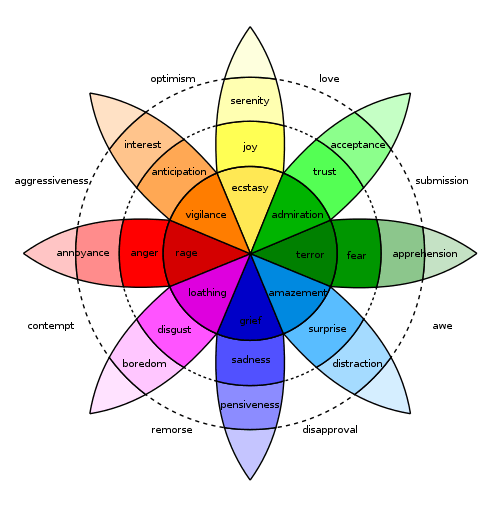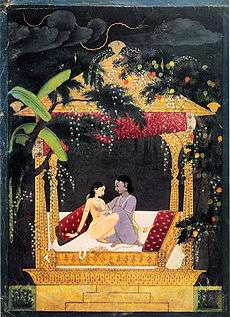Love
Love encompasses a range of strong and positive emotional and mental states, from the most sublime virtue or good habit, the deepest interpersonal affection and to the simplest pleasure.[1][2] An example of this range of meanings is that the love of a mother differs from the love of a spouse, which differs from the love of food. Most commonly, love refers to a feeling of strong attraction and emotional attachment.[3]
| Part of a series on |
| Love |
|---|
Red-outline heart icon |
|
Types of love
|
Love is considered to be a positive and negative: with its virtue representing human kindness, compassion, and affection, as "the unselfish loyal and benevolent concern for the good of another"; and its vice representing human moral flaw, akin to vanity, selfishness, amour-propre, and egotism, as it potentially leads people into a type of mania, obsessiveness or codependency.[4][5] It may also describe compassionate and affectionate actions towards other humans, one's self or animals.[6] In its various forms, love acts as a major facilitator of interpersonal relationships and, owing to its central psychological importance, is one of the most common themes in the creative arts.[7] Love has been postulated to be a function to keep human beings together against menaces and to facilitate the continuation of the species.[8]
Ancient Greek philosophers identified five forms of love: essentially, familial love (in Greek, Storge), friendly love or platonic love (Philia), romantic love (Eros), guest love (Xenia) and divine love (Agape). Modern authors have distinguished further varieties of love: unrequited love, empty love, companionate love, consummate love, infatuated love, self-love, and courtly love. Numerous cultures have also distinguished Ren, Yuanfen, Mamihlapinatapai, Cafuné, Kama, Bhakti, Mettā, Ishq, Chesed, Amore, Charity, Saudade (and other variants or symbioses of these states), as culturally unique words, definitions, or expressions of love in regards to a specified "moments" currently lacking in the English language.[9][10][11]
Scientific research on emotion has increased significantly over the past two decades. The color wheel theory of love defines three primary, three secondary and nine tertiary love styles, describing them in terms of the traditional color wheel. The triangular theory of love suggests "intimacy, passion and commitment" are core components of love. Love has additional religious or spiritual meaning. This diversity of uses and meanings combined with the complexity of the feelings involved makes love unusually difficult to consistently define, compared to other emotional states.
Definitions
_by_Ford_Maddox_Brown.jpg)
The word "love" can have a variety of related but distinct meanings in different contexts. Many other languages use multiple words to express some of the different concepts that in English are denoted as "love"; one example is the plurality of Greek words for "love" which includes agape and eros.[12] Cultural differences in conceptualizing love thus doubly impede the establishment of a universal definition.[13]
Although the nature or essence of love is a subject of frequent debate, different aspects of the word can be clarified by determining what isn't love (antonyms of "love"). Love as a general expression of positive sentiment (a stronger form of like) is commonly contrasted with hate (or neutral apathy). As a less-sexual and more-emotionally intimate form of romantic attachment, love is commonly contrasted with lust. As an interpersonal relationship with romantic overtones, love is sometimes contrasted with friendship, although the word love is often applied to close friendships or platonic love. (Further possible ambiguities come with usages "girlfriend", "boyfriend", "just good friends").
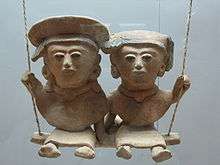
Abstractly discussed, love usually refers to an experience one person feels for another. Love often involves caring for, or identifying with, a person or thing (cf. vulnerability and care theory of love), including oneself (cf. narcissism). In addition to cross-cultural differences in understanding love, ideas about love have also changed greatly over time. Some historians date modern conceptions of romantic love to courtly Europe during or after the Middle Ages, although the prior existence of romantic attachments is attested by ancient love poetry.[14]
The complex and abstract nature of love often reduces discourse of love to a thought-terminating cliché. Several common proverbs regard love, from Virgil's "Love conquers all" to The Beatles' "All You Need Is Love". St. Thomas Aquinas, following Aristotle, defines love as "to will the good of another."[15] Bertrand Russell describes love as a condition of "absolute value," as opposed to relative value. Philosopher Gottfried Leibniz said that love is "to be delighted by the happiness of another."[16] Meher Baba stated that in love there is a "feeling of unity" and an "active appreciation of the intrinsic worth of the object of love."[17] Biologist Jeremy Griffith defines love as "unconditional selflessness".[18]
Impersonal
People can be said to love an object, principle, or goal to which they are deeply committed and greatly value. For example, compassionate outreach and volunteer workers' "love" of their cause may sometimes be born not of interpersonal love but impersonal love, altruism, and strong spiritual or political convictions.[19] People can also "love" material objects, animals, or activities if they invest themselves in bonding or otherwise identifying with those things. If sexual passion is also involved, then this feeling is called paraphilia.[20] A common principle that people say they love is life itself.
Interpersonal
Relationships (Outline) |
|---|
|
Endings |
Interpersonal love refers to love between human beings. It is a much more potent sentiment than a simple liking for a person. Unrequited love refers to those feelings of love that are not reciprocated. Interpersonal love is most closely associated with Interpersonal relationships.[19] Such love might exist between family members, friends, and couples. There are also a number of psychological disorders related to love, such as erotomania. Throughout history, philosophy and religion have done the most speculation on the phenomenon of love. In the 20th century, the science of psychology has written a great deal on the subject. In recent years, the sciences of psychology, anthropology, neuroscience, and biology have added to the understanding the concept of love.
Biological basis
Biological models of sex tend to view love as a mammalian drive, much like hunger or thirst.[21] Helen Fisher, an anthropologist and human behavior researcher, divides the experience of love into three partly overlapping stages: lust, attraction, and attachment. Lust is the feeling of sexual desire; romantic attraction determines what partners mates find attractive and pursue, conserving time and energy by choosing; and attachment involves sharing a home, parental duties, mutual defense, and in humans involves feelings of safety and security.[22] Three distinct neural circuitries, including neurotransmitters, and three behavioral patterns, are associated with these three romantic styles.[22]
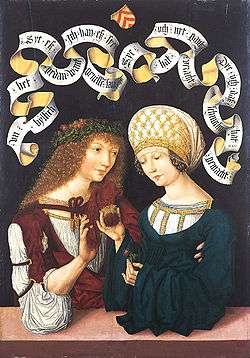
Lust is the initial passionate sexual desire that promotes mating, and involves the increased release of chemicals such as testosterone and estrogen. These effects rarely last more than a few weeks or months. Attraction is the more individualized and romantic desire for a specific candidate for mating, which develops out of lust as commitment to an individual mate forms. Recent studies in neuroscience have indicated that as people fall in love, the brain consistently releases a certain set of chemicals, including the neurotransmitter hormones, dopamine, norepinephrine, and serotonin, the same compounds released by amphetamine, stimulating the brain's pleasure center and leading to side effects such as increased heart rate, loss of appetite and sleep, and an intense feeling of excitement. Research has indicated that this stage generally lasts from one and a half to three years.[23]
Since the lust and attraction stages are both considered temporary, a third stage is needed to account for long-term relationships. Attachment is the bonding that promotes relationships lasting for many years and even decades. Attachment is generally based on commitments such as marriage and children, or mutual friendship based on things like shared interests. It has been linked to higher levels of the chemicals oxytocin and vasopressin to a greater degree than short-term relationships have.[23] Enzo Emanuele and coworkers reported the protein molecule known as the nerve growth factor (NGF) has high levels when people first fall in love, but these return to previous levels after one year.[24]
Psychological basis

Psychology depicts love as a cognitive and social phenomenon. Psychologist Robert Sternberg formulated a triangular theory of love and argued that love has three different components: intimacy, commitment, and passion. Intimacy is a form in which two people share confidences and various details of their personal lives, and is usually shown in friendships and romantic love affairs. Commitment, on the other hand, is the expectation that the relationship is permanent. The last form of love is sexual attraction and passion. Passionate love is shown in infatuation as well as romantic love. All forms of love are viewed as varying combinations of these three components. Non-love does not include any of these components. Liking only includes intimacy. Infatuated love only includes passion. Empty love only includes commitment. Romantic love includes both intimacy and passion. Companionate love includes intimacy and commitment. Fatuous love includes passion and commitment. Lastly, consummate love includes all three components.[25] American psychologist Zick Rubin sought to define love by psychometrics in the 1970s. His work states that three factors constitute love: attachment, caring, and intimacy.[26][27]
Following developments in electrical theories such as Coulomb's law, which showed that positive and negative charges attract, analogs in human life were developed, such as "opposites attract". Over the last century, research on the nature of human mating has generally found this not to be true when it comes to character and personality—people tend to like people similar to themselves. However, in a few unusual and specific domains, such as immune systems, it seems that humans prefer others who are unlike themselves (e.g., with an orthogonal immune system), since this will lead to a baby that has the best of both worlds.[28] In recent years, various human bonding theories have been developed, described in terms of attachments, ties, bonds, and affinities. Some Western authorities disaggregate into two main components, the altruistic and the narcissistic. This view is represented in the works of Scott Peck, whose work in the field of applied psychology explored the definitions of love and evil. Peck maintains that love is a combination of the "concern for the spiritual growth of another," and simple narcissism.[29] In combination, love is an activity, not simply a feeling.
Psychologist Erich Fromm maintained in his book The Art of Loving that love is not merely a feeling but is also actions, and that in fact, the "feeling" of love is superficial in comparison to one's commitment to love via a series of loving actions over time.[19] In this sense, Fromm held that love is ultimately not a feeling at all, but rather is a commitment to, and adherence to, loving actions towards another, oneself, or many others, over a sustained duration.[19] Fromm also described love as a conscious choice that in its early stages might originate as an involuntary feeling, but which then later no longer depends on those feelings, but rather depends only on conscious commitment.[19]
Evolutionary basis
.jpg)
Evolutionary psychology has attempted to provide various reasons for love as a survival tool. Humans are dependent on parental help for a large portion of their lifespans compared to other mammals. Love has therefore been seen as a mechanism to promote parental support of children for this extended time period. Furthermore, researchers as early as Charles Darwin himself identified unique features of human love compared to other mammals and credit love as a major factor for creating social support systems that enabled the development and expansion of the human species.[30] Another factor may be that sexually transmitted diseases can cause, among other effects, permanently reduced fertility, injury to the fetus, and increase complications during childbirth. This would favor monogamous relationships over polygamy.[31]
Comparison of scientific models
Biological models of love tend to see it as a mammalian drive, similar to hunger or thirst.[21] Psychology sees love as more of a social and cultural phenomenon. Certainly, love is influenced by hormones (such as oxytocin), neurotrophins (such as NGF), and pheromones, and how people think and behave in love is influenced by their conceptions of love. The conventional view in biology is that there are two major drives in love: sexual attraction and attachment. Attachment between adults is presumed to work on the same principles that lead an infant to become attached to its mother. The traditional psychological view sees love as being a combination of companionate love and passionate love. Passionate love is intense longing, and is often accompanied by physiological arousal (shortness of breath, rapid heart rate); companionate love is affection and a feeling of intimacy not accompanied by physiological arousal.
Cultural views
Ancient Greek
Greek distinguishes several different senses in which the word "love" is used. Ancient Greeks identified four forms of love: kinship or familiarity (in Greek, storge), friendship and/or platonic desire (philia), sexual and/or romantic desire (eros), and self-emptying or divine love (agape).[32][33] Modern authors have distinguished further varieties of romantic love.[34] However, with Greek (as with many other languages), it has been historically difficult to separate the meanings of these words totally. At the same time, the Ancient Greek text of the Bible has examples of the verb agapo having the same meaning as phileo.
Agape (ἀγάπη agápē) means love in modern-day Greek. The term s'agapo means I love you in Greek. The word agapo is the verb I love. It generally refers to a "pure," ideal type of love, rather than the physical attraction suggested by eros. However, there are some examples of agape used to mean the same as eros. It has also been translated as "love of the soul."[35]
Eros (ἔρως érōs) (from the Greek deity Eros) is passionate love, with sensual desire and longing. The Greek word erota means in love. Plato refined his own definition. Although eros is initially felt for a person, with contemplation it becomes an appreciation of the beauty within that person, or even becomes appreciation of beauty itself. Eros helps the soul recall knowledge of beauty and contributes to an understanding of spiritual truth. Lovers and philosophers are all inspired to seek truth by eros. Some translations list it as "love of the body".[35]
Philia (φιλία philía), a dispassionate virtuous love, was a concept addressed and developed by Aristotle in his Nicomachean Ethics Book VIII.[36] It includes loyalty to friends, family, and community, and requires virtue, equality, and familiarity. Philia is motivated by practical reasons; one or both of the parties benefit from the relationship. It can also mean "love of the mind."
Storge (στοργή storgē) is natural affection, like that felt by parents for offspring.
Xenia (ξενία xenía), hospitality, was an extremely important practice in ancient Greece. It was an almost ritualized friendship formed between a host and his guest, who could previously have been strangers. The host fed and provided quarters for the guest, who was expected to repay only with gratitude. The importance of this can be seen throughout Greek mythology—in particular, Homer's Iliad and Odyssey.
Ancient Roman (Latin)
The Latin language has several different verbs corresponding to the English word "love." amō is the basic verb meaning I love, with the infinitive amare ("to love") as it still is in Italian today. The Romans used it both in an affectionate sense as well as in a romantic or sexual sense. From this verb come amans—a lover, amator, "professional lover," often with the accessory notion of lechery—and amica, "girlfriend" in the English sense, often being applied euphemistically to a prostitute. The corresponding noun is amor (the significance of this term for the Romans is well illustrated in the fact, that the name of the City, Rome—in Latin: Roma—can be viewed as an anagram for amor, which was used as the secret name of the City in wide circles in ancient times),[37] which is also used in the plural form to indicate love affairs or sexual adventures. This same root also produces amicus—"friend"—and amicitia, "friendship" (often based to mutual advantage, and corresponding sometimes more closely to "indebtedness" or "influence"). Cicero wrote a treatise called On Friendship (de Amicitia), which discusses the notion at some length. Ovid wrote a guide to dating called Ars Amatoria (The Art of Love), which addresses, in depth, everything from extramarital affairs to overprotective parents.
Latin sometimes uses amāre where English would simply say to like. This notion, however, is much more generally expressed in Latin by the terms placere or delectāre, which are used more colloquially, the latter used frequently in the love poetry of Catullus. Diligere often has the notion "to be affectionate for," "to esteem," and rarely if ever is used for romantic love. This word would be appropriate to describe the friendship of two men. The corresponding noun diligentia, however, has the meaning of "diligence" or "carefulness," and has little semantic overlap with the verb. Observare is a synonym for diligere; despite the cognate with English, this verb and its corresponding noun, observantia, often denote "esteem" or "affection." Caritas is used in Latin translations of the Christian Bible to mean "charitable love"; this meaning, however, is not found in Classical pagan Roman literature. As it arises from a conflation with a Greek word, there is no corresponding verb.
Chinese and other Sinic

Two philosophical underpinnings of love exist in the Chinese tradition, one from Confucianism which emphasized actions and duty while the other came from Mohism which championed a universal love. A core concept to Confucianism is 仁 (Ren, "benevolent love"), which focuses on duty, action and attitude in a relationship rather than love itself. In Confucianism, one displays benevolent love by performing actions such as filial piety from children, kindness from parents, loyalty to the king and so forth.
The concept of 愛 (Mandarin: ài) was developed by the Chinese philosopher Mozi in the 4th century BC in reaction to Confucianism's benevolent love. Mozi tried to replace what he considered to be the long-entrenched Chinese over-attachment to family and clan structures with the concept of "universal love" (兼愛, jiān'ài). In this, he argued directly against Confucians who believed that it was natural and correct for people to care about different people in different degrees. Mozi, by contrast, believed people in principle should care for all people equally. Mohism stressed that rather than adopting different attitudes towards different people, love should be unconditional and offered to everyone without regard to reciprocation; not just to friends, family and other Confucian relations. Later in Chinese Buddhism, the term Ai (愛) was adopted to refer to a passionate, caring love and was considered a fundamental desire. In Buddhism, Ai was seen as capable of being either selfish or selfless, the latter being a key element towards enlightenment.
In Mandarin Chinese, 愛 (ài) is often used as the equivalent of the Western concept of love. 愛 (ài) is used as both a verb (e.g. 我愛你, Wǒ ài nǐ, or "I love you") and a noun (such as 愛情 àiqíng, or "romantic love"). However, due to the influence of Confucian 仁 (rén), the phrase 我愛你 (Wǒ ài nǐ, I love you) carries with it a very specific sense of responsibility, commitment and loyalty. Instead of frequently saying "I love you" as in some Western societies, the Chinese are more likely to express feelings of affection in a more casual way. Consequently, "I like you" (我喜欢你, Wǒ xǐhuan nǐ) is a more common way of expressing affection in Mandarin; it is more playful and less serious.[38] This is also true in Japanese (suki da, 好きだ).
Japanese
The Japanese language uses three words to convey the English equivalent of "love". Because "love" covers a wide range of emotions and behavioral phenomena, there are nuances distinguishing the three terms.[39][40] The term ai (愛), which is often associated with maternal love[39] or selfless love,[40] originally referred to beauty and was often used in religious context. Following the Meiji Restoration 1868, the term became associated with "love" in order to translate Western literature. Prior to Western influence, the term koi (恋) generally represented romantic love, and was often the subject of the popular Man'yōshū Japanese poetry collection.[39] Koi describes a longing for a member of the opposite sex and is typically interpreted as selfish and wanting.[40] The term's origins come from the concept of lonely solitude as a result of separation from a loved one. Though modern usage of koi focuses on sexual love and infatuation, the Manyō used the term to cover a wider range of situations, including tenderness, benevolence, and material desire.[39] The third term, ren'ai (恋愛), is a more modern construction that combines the kanji characters for both ai and koi, though its usage more closely resembles that of koi in the form of romantic love.[39][40]
Indian
In contemporary literature, kama refers usually to sexual desire.[41][42] However, the term also refers to any sensory enjoyment, emotional attraction and aesthetic pleasure such as from arts, dance, music, painting, sculpture and nature.[43][44]
The concept kama is found in some of the earliest known verses in Vedas. For example, Book 10 of Rig Veda describes the creation of the universe from nothing by the great heat. There in hymn 129, it states:
कामस्तदग्रे समवर्तताधि मनसो रेतः परथमं यदासीत |
सतो बन्धुमसति निरविन्दन हर्दि परतीष्याकवयो मनीषा ||[45]
Thereafter rose Desire in the beginning, Desire the primal seed and germ of Spirit,
Sages who searched with their heart's thought discovered the existent's kinship in the non-existent.
Persian
The children of Adam are limbs of one body
Having been created of one essence.
When the calamity of time afflicts one limb
The other limbs cannot remain at rest.
If you have no sympathy for the troubles of others
You are not worthy to be called by the name of "man".
Sa'di, Gulistan
Rumi, Hafiz and Sa'di are icons of the passion and love that the Persian culture and language present. The Persian word for love is Ishq, which is derived from Arabic language; however, it is considered by most to be too stalwart a term for interpersonal love and is more commonly substituted for "doost dashtan" ("liking"). In the Persian culture, everything is encompassed by love and all is for love, starting from loving friends and family, husbands and wives, and eventually reaching the divine love that is the ultimate goal in life.
Religious views
Abrahamic

Judaism
In Hebrew, אהבה (ahava) is the most commonly used term for both interpersonal love and love between God and God's creations. Chesed, often translated as loving-kindness, is used to describe many forms of love between human beings.
The commandment to love other people is given in the Torah, which states, "Love your neighbor like yourself" (Leviticus 19:18). The Torah's commandment to love God "with all your heart, with all your soul and with all your might" (Deuteronomy 6:5) is taken by the Mishnah (a central text of the Jewish oral law) to refer to good deeds, willingness to sacrifice one's life rather than commit certain serious transgressions, willingness to sacrifice all of one's possessions, and being grateful to the Lord despite adversity (tractate Berachoth 9:5). Rabbinic literature differs as to how this love can be developed, e.g., by contemplating divine deeds or witnessing the marvels of nature.
As for love between marital partners, this is deemed an essential ingredient to life: "See life with the wife you love" (Ecclesiastes 9:9). Rabbi David Wolpe writes that "...love is not only about the feelings of the lover...It is when one person believes in another person and shows it." He further states that "...love...is a feeling that expresses itself in action. What we really feel is reflected in what we do."[47] The biblical book Song of Solomon is considered a romantically phrased metaphor of love between God and his people, but in its plain reading, reads like a love song. The 20th-century rabbi Eliyahu Eliezer Dessler is frequently quoted as defining love from the Jewish point of view as "giving without expecting to take" (from his Michtav me-Eliyahu, Vol. 1).
Christianity
The Christian understanding is that love comes from God. The love of man and woman—eros in Greek—and the unselfish love of others (agape), are often contrasted as "descending" and "ascending" love, respectively, but are ultimately the same thing.[48]
There are several Greek words for "love" that are regularly referred to in Christian circles.
- Agape: In the New Testament, agapē is charitable, selfless, altruistic, and unconditional. It is parental love, seen as creating goodness in the world; it is the way God is seen to love humanity, and it is seen as the kind of love that Christians aspire to have for one another.[35]
- Phileo: Also used in the New Testament, phileo is a human response to something that is found to be delightful. Also known as "brotherly love."
- Two other words for love in the Greek language, eros (sexual love) and storge (child-to-parent love), were never used in the New Testament.[35]
Christians believe that to Love God with all your heart, mind, and strength and Love your neighbor as yourself are the two most important things in life (the greatest commandment of the Jewish Torah, according to Jesus; cf. Gospel of Mark chapter 12, verses 28–34). Saint Augustine summarized this when he wrote "Love God, and do as thou wilt."
The Apostle Paul glorified love as the most important virtue of all. Describing love in the famous poetic interpretation in 1 Corinthians, he wrote, "Love is patient, love is kind. It does not envy, it does not boast, it is not proud. It is not rude, it is not self-seeking, it is not easily angered, it keeps no record of wrongs. Love does not delight in evil but rejoices with the truth. It always protects, always trusts, always hopes, and always perseveres." (1 Cor. 13:4–7, NIV)
The Apostle John wrote, "For God so loved the world that he gave his one and only Son, that whoever believes in him shall not perish but have eternal life. For God did not send his Son into the world to condemn the world, but to save the world through him." (John 3:16–17, NIV) John also wrote, "Dear friends, let us love one another for love comes from God. Everyone who loves has been born of God and knows God. Whoever does not love does not know God, because God is love." (1 John 4:7–8, NIV)

Saint Augustine says that one must be able to decipher the difference between love and lust. Lust, according to Saint Augustine, is an overindulgence, but to love and be loved is what he has sought for his entire life. He even says, "I was in love with love." Finally, he does fall in love and is loved back, by God. Saint Augustine says the only one who can love you truly and fully is God, because love with a human only allows for flaws such as "jealousy, suspicion, fear, anger, and contention." According to Saint Augustine, to love God is "to attain the peace which is yours." (Saint Augustine's Confessions)
Augustine regards the duplex commandment of love in Matthew 22 as the heart of Christian faith and the interpretation of the Bible. After the review of Christian doctrine, Augustine treats the problem of love in terms of use and enjoyment until the end of Book I of De Doctrina Christiana (1.22.21–1.40.44;).[50]
Christian theologians see God as the source of love, which is mirrored in humans and their own loving relationships. Influential Christian theologian C. S. Lewis wrote a book called The Four Loves. Benedict XVI named his first encyclical God is love. He said that a human being, created in the image of God, who is love, is able to practice love; to give himself to God and others (agape) and by receiving and experiencing God's love in contemplation (eros). This life of love, according to him, is the life of the saints such as Teresa of Calcutta and the Blessed Virgin Mary and is the direction Christians take when they believe that God loves them.[48]
Pope Francis taught that "True love is both loving and letting oneself be loved...what is important in love is not our loving, but allowing ourselves to be loved by God."[51] And so, in the analysis of a Catholic theologian, for Pope Francis, "the key to love...is not our activity. It is the activity of the greatest, and the source, of all the powers in the universe: God's."[52]
In Christianity the practical definition of love is summarised by St. Thomas Aquinas, who defined love as "to will the good of another," or to desire for another to succeed.[15] This is an explanation of the Christian need to love others, including their enemies. As Thomas Aquinas explains, Christian love is motivated by the need to see others succeed in life, to be good people.
Regarding love for enemies, Jesus is quoted in the Gospel of Matthew chapter five:
"You have heard that it was said, 'Love your neighbor and hate your enemy.' But I tell you, love your enemies and pray for those who persecute you, that you may be children of your Father in heaven. He causes his sun to rise on the evil and the good, and sends rain on the righteous and the unrighteous. If you love those who love you, what reward will you get? Are not even the tax collectors doing that? And if you greet only your own people, what are you doing more than others? Do not even pagans do that? Be perfect, therefore, as your heavenly Father is perfect." – Matthew 5: 43–48.
Do not forget to love with forgiveness, Christ saved an adulterous woman from those who would stone her. A world of wronged hypocrites needs forgiving love. Mosaic Law would hold Deuteronomy 22:22-24 "If a man is found lying with a woman married to a husband, then both of them shall die—the man that lay with the woman, and the woman; so you shall put away the evil from Israel. If a young woman who is a virgin is betrothed to a husband, and a man finds her in the city and lies with her, then you shall bring them both out to the gate of that city, and you shall stone them to death with stones, the young woman because she did not cry out in the city, and the man because he humbled his neighbor's wife; so you shall put away the evil from among you."[53]
Tertullian wrote regarding love for enemies: "Our individual, extraordinary, and perfect goodness consists in loving our enemies. To love one's friends is common practice, to love one's enemies only among Christians."[54]
Islam

Love encompasses the Islamic view of life as universal brotherhood that applies to all who hold faith. Amongst the 99 names of God (Allah), there is the name Al-Wadud, or "the Loving One," which is found in Surah [Quran 11:90] as well as Surah [Quran 85:14]. God is also referenced at the beginning of every chapter in the Qur'an as Ar-Rahman and Ar-Rahim, or the "Most Compassionate" and the "Most Merciful", indicating that nobody is more loving, compassionate and benevolent than God. The Qur'an refers to God as being "full of loving kindness."
The Qur'an exhorts Muslim believers to treat all people, those who have not persecuted them, with birr or "deep kindness" as stated in Surah [Quran 6:8-9]. Birr is also used by the Qur'an in describing the love and kindness that children must show to their parents.
Ishq, or divine love, is the emphasis of Sufism in the Islamic tradition. Practitioners of Sufism believe that love is a projection of the essence of God to the universe. God desires to recognize beauty, and as if one looks at a mirror to see oneself, God "looks" at himself within the dynamics of nature. Since everything is a reflection of God, the school of Sufism practices to see the beauty inside the apparently ugly. Sufism is often referred to as the religion of love.[55] God in Sufism is referred to in three main terms, which are the Lover, Loved, and Beloved, with the last of these terms being often seen in Sufi poetry. A common viewpoint of Sufism is that through love, humankind can get back to its inherent purity and grace. The saints of Sufism are infamous for being "drunk" due to their love of God; hence, the constant reference to wine in Sufi poetry and music.
Bahá'í Faith
In his Paris Talks, `Abdu'l-Bahá described four types of love: the love that flows from God to human beings; the love that flows from human beings to God; the love of God towards the Self or Identity of God; and the love of human beings for human beings.[56]
Indian
Buddhism
In Buddhism, Kāma is sensuous, sexual love. It is an obstacle on the path to enlightenment, since it is selfish. Karuṇā is compassion and mercy, which reduces the suffering of others. It is complementary to wisdom and is necessary for enlightenment. Adveṣa and mettā are benevolent love. This love is unconditional and requires considerable self-acceptance. This is quite different from ordinary love, which is usually about attachment and sex and which rarely occurs without self-interest. Instead, in Buddhism it refers to detachment and unselfish interest in others' welfare.
The Bodhisattva ideal in Mahayana Buddhism involves the complete renunciation of oneself in order to take on the burden of a suffering world. The strongest motivation one has in order to take the path of the Bodhisattva is the idea of salvation within unselfish, altruistic love for all sentient beings.
Hinduism
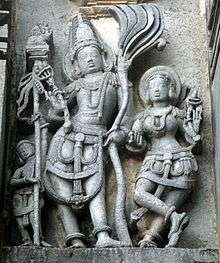
In Hinduism, kāma is pleasurable, sexual love, personified by the god Kamadeva. For many Hindu schools, it is the third end (Kama) in life. Kamadeva is often pictured holding a bow of sugar cane and an arrow of flowers; he may ride upon a great parrot. He is usually accompanied by his consort Rati and his companion Vasanta, lord of the spring season. Stone images of Kamadeva and Rati can be seen on the door of the Chennakeshava temple at Belur, in Karnataka, India. Maara is another name for kāma.
In contrast to kāma, prema – or prem – refers to elevated love. Karuna is compassion and mercy, which impels one to help reduce the suffering of others. Bhakti is a Sanskrit term, meaning "loving devotion to the supreme God." A person who practices bhakti is called a bhakta. Hindu writers, theologians, and philosophers have distinguished nine forms of bhakti, which can be found in the Bhagavata Purana and works by Tulsidas. The philosophical work Narada Bhakti Sutras, written by an unknown author (presumed to be Narada), distinguishes eleven forms of love.
In certain Vaishnava sects within Hinduism, attaining unadulterated, unconditional and incessant love for Godhead is considered the foremost goal of life. Gaudiya Vaishnavas who worship Krishna as the Supreme Personality of Godhead and the cause of all causes consider Love for Godhead (Prema) to act in two ways: sambhoga and vipralambha (union and separation)—two opposites.[57]
In the condition of separation, there is an acute yearning for being with the beloved and in the condition of union, there is supreme happiness and nectarean. Gaudiya Vaishnavas consider that Krishna-prema (Love for Godhead) is not fire but that it still burns away one's material desires. They consider that Kṛṣṇa-prema is not a weapon, but it still pierces the heart. It is not water, but it washes away everything—one's pride, religious rules, and one's shyness. Krishna-prema is considered to make one drown in the ocean of transcendental ecstasy and pleasure. The love of Radha, a cowherd girl, for Krishna is often cited as the supreme example of love for Godhead by Gaudiya Vaishnavas. Radha is considered to be the internal potency of Krishna, and is the supreme lover of Godhead. Her example of love is considered to be beyond the understanding of material realm as it surpasses any form of selfish love or lust that is visible in the material world. The reciprocal love between Radha (the supreme lover) and Krishna (God as the Supremely Loved) is the subject of many poetic compositions in India such as the Gita Govinda and Hari Bhakti Shuddhodhaya.
In the Bhakti tradition within Hinduism, it is believed that execution of devotional service to God leads to the development of Love for God (taiche bhakti-phale krsne prema upajaya), and as love for God increases in the heart, the more one becomes free from material contamination (krishna-prema asvada haile, bhava nasa paya). Being perfectly in love with God or Krishna makes one perfectly free from material contamination. and this is the ultimate way of salvation or liberation. In this tradition, salvation or liberation is considered inferior to love, and just an incidental by-product. Being absorbed in Love for God is considered to be the perfection of life.[58]
Political views
Free love
The term "free love" has been used[59] to describe a social movement that rejects marriage, which is seen as a form of social bondage. The Free Love movement's initial goal was to separate the state from sexual matters such as marriage, birth control, and adultery. It claimed that such issues were the concern of the people involved, and no one else.[60]
Many people in the early 19th century believed that marriage was an important aspect of life to "fulfill earthly human happiness." Middle-class Americans wanted the home to be a place of stability in an uncertain world. This mentality created a vision of strongly defined gender roles, which provoked the advancement of the free love movement as a contrast.[61]
The term "sex radical" has been used interchangeably with the term "free lover". By whatever name, advocates had two strong beliefs: opposition to the idea of forceful sexual activity in a relationship and advocacy for a woman to use her body in any way that she pleases.[62] These are also beliefs of Feminism.[63]
Philosophical views
The philosophy of love is a field of social philosophy and ethics that attempts to explain the nature of love.[64] The philosophical investigation of love includes the tasks of distinguishing between the various kinds of personal love, asking if and how love is or can be justified, asking what the value of love is, and what impact love has on the autonomy of both the lover and the beloved.[63]
See also
- Color wheel theory of love
- Human bonding
- Love at first sight
- Polyamory
- Romance (love)
- Self-love
- Social connection
- Traditional forms, Agape, Philia, Philautia, Storge, Eros: Greek terms for love
References
- "Definition of Love in English". Oxford English Dictionary. Archived from the original on 2 May 2018. Retrieved 1 May 2018.
- "Definition of "Love" - English Dictionary". Cambridge English Dictionary. Archived from the original on 2 May 2018. Retrieved 1 May 2018.
- Oxford Illustrated American Dictionary (1998) Merriam-Webster Collegiate Dictionary (2000)
- Roget's Thesaurus (1998) p. 592 and p. 639
- "Love – Definition of love by Merriam-Webster". merriam-webster.com. Archived from the original on 12 January 2012. Retrieved 14 December 2011.
- Fromm, Erich; The Art of Loving, Harper Perennial (1956), Original English Version, ISBN 978-0-06-095828-2
- "Article On Love". Archived from the original on 30 May 2012. Retrieved 13 September 2011.
- Helen Fisher. Why We Love: the nature and chemistry of romantic love. 2004.
- https://www.huffpost.com/entry/what-is-love-a-philosophy_b_5697322
- Liddell and Scott: φιλία Archived 3 January 2017 at the Wayback Machine
- Mascaró, Juan (2003). The Bhagavad Gita. Penguin Classics. Penguin. ISBN 978-0-14-044918-1. (J. Mascaró, translator)
- Anders Nygren, Agape and Eros.
- Kay, Paul; Kempton, Willett (March 1984). "What is the Sapir–Whorf Hypothesis?". American Anthropologist. New Series. 86 (1): 65–79. doi:10.1525/aa.1984.86.1.02a00050.
- "Ancient Love Poetry". Archived from the original on 30 September 2007.
- "St. Thomas Aquinas, STh I–II, 26, 4, corp. art". Newadvent.org. Archived from the original on 9 November 2011. Retrieved 30 October 2010.
- Leibniz, Gottfried. "Confessio philosophi". Wikisource edition. Archived from the original on 27 April 2009. Retrieved 25 March 2009.
- Baba, Meher (1995). Discourses. Myrtle Beach: Sheriar Press. p. 113. ISBN 978-1-880619-09-4.
- What is love?. In The Book of Real Answers to Everything! Archived 16 January 2013 at the Wayback Machine Griffith, J. 2011. ISBN 978-1-74129-007-3.
- Fromm, Erich; The Art of Loving, Harper Perennial (5 September 2000), Original English Version, ISBN 978-0-06-095828-2
- DiscoveryHealth. "Paraphilia". Archived from the original on 12 December 2007. Retrieved 16 December 2007.
- Lewis, Thomas; Amini, F.; Lannon, R. (2000). A General Theory of Love. Random House. ISBN 978-0-375-70922-7.
- "Archived copy" (PDF). Archived from the original (PDF) on 28 June 2011. Retrieved 3 October 2011.CS1 maint: archived copy as title (link) Defining the Brain Systems of Lust, Romantic Attraction, and Attachment by Fisher et al.
- Winston, Robert (2004). Human. Smithsonian Institution. ISBN 978-0-03-093780-4.
- Emanuele, E.; Polliti, P.; Bianchi, M.; Minoretti, P.; Bertona, M.; Geroldi, D. (2005). "Raised plasma nerve growth factor levels associated with early-stage romantic love". Psychoneuroendocrinology. 31 (3): 288–294. doi:10.1016/j.psyneuen.2005.09.002. PMID 16289361. Archived from the original on 6 December 2006. Retrieved 3 December 2006.
- Sternberg, R.J. (1986). "A triangular theory of love". Psychological Review. 93 (2): 119–135. doi:10.1037/0033-295x.93.2.119.
- Rubin, Zick (1970). "Measurement of Romantic Love". Journal of Personality and Social Psychology. 16 (2): 265–273. CiteSeerX 10.1.1.452.3207. doi:10.1037/h0029841. PMID 5479131.
- Rubin, Zick (1973). Liking and Loving: an invitation to social psychology. New York: Holt, Rinehart & Winston.
- Berscheid, Ellen; Walster, Elaine H. (1969). Interpersonal Attraction. Addison-Wesley Publishing Co. ISBN 978-0-201-00560-8. CCCN 69-17443.
- Peck, Scott (1978). The Road Less Traveled. Simon & Schuster. p. 169. ISBN 978-0-671-25067-6.
- Loye, David S. (2000). Darwin's Lost Theory of Love: A Healing Vision for the 21st Century. iUniverse. p. 332. ISBN 978-0-595-00131-6.
- The Handbook of Evolutionary Psychology, edited by David M. Buss, John Wiley & Sons, Inc., 2005. Chapter 14, Commitment, Love, and Mate Retention by Lorne Campbell and Bruce J. Ellis.
- C. S. Lewis, The Four Loves, 1960.
- Kristeller, Paul Oskar (1980). Renaissance Thought and the Arts: Collected Essays. Princeton University Press. ISBN 978-0-691-02010-5.
- Stendhal, in his book On Love ("De l'amour"; Paris, 1822), distinguished carnal love, passionate love, a kind of uncommitted love that he called "taste-love", and love of vanity. Denis de Rougemont in his book Love in the Western World traced the story of passionate love (l'amour-passion) from its courtly to its romantic forms. Benjamin Péret, in the introduction to his Anthology of Sublime Love (Paris, 1956), further identified "sublime love", a state of realized idealisation perhaps equatable with the romantic form of passionate love.
- Anders Theodor Samuel Nygren, Eros and Agape (first published in Swedish, 1930–1936).
- "Philosophy of Love | Internet Encyclopedia of Philosophy". www.iep.utm.edu. Archived from the original on 29 August 2017. Retrieved 24 August 2017.
- Thomas Köves-Zulauf, Reden und Schweigen, Munich, 1972.
- JFK Miller, "Why the Chinese Don't Say I Love You Archived 24 January 2010 at the Wayback Machine"
- Ryang, Sonia (2006). Love in Modern Japan: Its Estrangement from Self, Sex and Society. Routledge. pp. 13–14. ISBN 978-1-135-98863-0. Archived from the original on 11 July 2016. Retrieved 3 February 2016.
- Abe, Namiko. "Japanese Words for "Love": The Difference between "Ai" and "Koi"". About.com. Archived from the original on 5 November 2014. Retrieved 5 November 2014.
- Monier Williams, काम, kāma Archived 19 October 2017 at the Wayback Machine Monier-Williams Sanskrit English Dictionary, p. 271, see 3rd column
- James Lochtefeld (2002), The Illustrated Encyclopedia of Hinduism, Volume 1, Rosen Publishing, New York, ISBN 0-8239-2287-1, p. 340
- See:
- Kate Morris (2011), The Illustrated Dictionary of History, ISBN 978-81-89093-37-2, p. 124;
- Robert E. Van Voorst, RELG: World, Wadsworth, ISBN 978-1-111-72620-1, p. 78
- R. Prasad (2008), History of Science, Philosophy and Culture in Indian Civilization, Volume 12, Part 1, ISBN 978-81-8069-544-5, pp. 249–270
- Rig Veda Book 10 Hymn 129 Archived 16 February 2018 at the Wayback Machine Verse 4
- Ralph Griffith (Translator, 1895), The Hymns of the Rig veda Archived 10 April 2016 at the Wayback Machine, Book X, Hymn CXXIX, Verse 4, p. 575
- Wolpe, David (16 February 2016). "We Are Defining Love the Wrong Way". Time. Archived from the original on 26 February 2019. Retrieved 14 February 2019.
- Pope Benedict XVI. "papal encyclical, Deus Caritas Est". Archived from the original on 8 October 2011. Retrieved 11 June 2008.
- http://www.wga.hu/html_m/b/baglione/sacred2.html Archived 14 March 2017 at the Wayback Machine Description of Sacred and Profane Love
- Woo, B. Hoon (2013). "Augustine's Hermeneutics and Homiletics in De doctrina christiana". Journal of Christian Philosophy. 17: 97–117.
- "Sri Lanka – Philippines: Meeting with the young people in the sports field of Santo Tomas University (Manila, 18 January 2015) – Francis". w2.vatican.va. Archived from the original on 23 February 2018. Retrieved 24 February 2018.
- Nidoy, Raul. "The key to love according to Pope Francis". Archived from the original on 24 February 2018. Retrieved 24 February 2018.
- Jesus and the woman taken in adultery
- Swartley, Willard M. (1992). The Love of Enemy and Nonretaliation in the New Testament, Studies in peace and scripture; (As Scapulam I) cited by Hans Haas, Idee und Ideal de Feindesliebe in der ausserchristlichen Welt (Leipzig: University of Leipzig, 1927). Westminster John Knox Press. p. 24. ISBN 978-0-664-25354-7.
- Lewisohn, Leonard (2014). Cambridge Companions to Religion. Cambridge: Cambridge University Press. pp. 150–180.
- "Bahá'í Reference Library – Paris Talks". reference.bahai.org. pp. 179–181. Archived from the original on 20 August 2014. Retrieved 4 September 2014.
- Gour Govinda Swami. "Wonderful Characteristic of Krishna Prema, Gour Govinda Swami". Archived from the original on 29 November 2012. Retrieved 7 January 2012.
- A C Bhaktivedanta Swami. "Being Perfectly in Love". Archived from the original on 23 November 2014. Retrieved 7 January 2012.
- The Handbook Archived 13 June 2010 at the Wayback Machine of the Oneida Community claims to have coined the term around 1850, and laments that its use was appropriated by socialists to attack marriage, an institution that they felt protected women and children from abandonment
- McElroy, Wendy (1996). "The Free Love Movement and Radical Individualism". Libertarian Enterprise. 19: 1.
- Spurlock, John C. Free Love Marriage and Middle-Class Radicalism in America. New York, NY: New York UP, 1988.
- Passet, Joanne E. Sex Radicals and the Quest for Women's Equality. Chicago: U of Illinois P, 2003.
- Laurie, Timothy; Stark, Hannah (2017), "Love's Lessons: Intimacy, Pedagogy and Political Community", Angelaki: Journal of the Theoretical Humanities, 22 (4): 69–79, doi:10.1080/0969725x.2017.1406048
- Soren Kierkegaard. Works of Love.
Sources
- Chadwick, Henry (1998). Saint Augustine Confessions. Oxford: Oxford University Press. ISBN 978-0-19-283372-3.
- Fisher, Helen (2004). Why We Love: the Nature and Chemistry of Romantic Love. New York : H. Holt. ISBN 978-0-8050-6913-6.
- Giles, James (1994). "A theory of love and sexual desire". Journal for the Theory of Social Behaviour. 24 (4): 339–357. doi:10.1111/j.1468-5914.1994.tb00259.x.
- Kierkegaard, Søren (2009). Works of Love. New York City: Harper Perennial Modern Classics. ISBN 978-0-06-171327-9.
- Oord, Thomas Jay (2010). Defining Love: A Philosophical, Scientific, and Theological Engagement. Grand Rapids, MI: Brazos. ISBN 978-1-58743-257-6.
- Singer, Irving (1966). The Nature of Love. (in three volumes) (v.1 reprinted and later volumes from The University of Chicago Press, 1984 ed.). Random House. ISBN 978-0-226-76094-0.
- Sternberg, R.J. (1986). "A triangular theory of love". Psychological Review. 93 (2): 119–135. doi:10.1037/0033-295X.93.2.119.
- Sternberg, R.J. (1987). "Liking versus loving: A comparative evaluation of theories". Psychological Bulletin. 102 (3): 331–345. doi:10.1037/0033-2909.102.3.331.
- Tennov, Dorothy (1979). Love and Limerence: the Experience of Being in Love. New York: Stein and Day. ISBN 978-0-8128-6134-1.
- Wood Samuel E., Ellen Wood and Denise Boyd (2005). The World of Psychology (5th ed.). Pearson Education. pp. 402–403. ISBN 978-0-205-35868-7.
Further reading
- Bayer, A, ed. (2008). Art and love in Renaissance Italy. New York: The Metropolitan Museum of Art.
External links
- History of Love, Internet Encyclopedia of Philosophy
- Friendship at Curlie
- Philanthropy at Curlie
- Romance at Curlie
